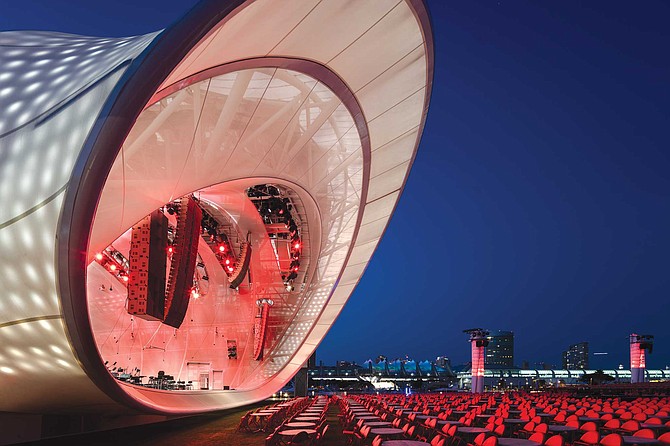 Facebook
Facebook
 X
X
 Instagram
Instagram
 TikTok
TikTok
 Youtube
Youtube

While the San Diego vibe might be dominated by flip-flops, microbrews, and disappointed Padres fans, something notable is brewing in the San Diego classical music scene. Since the end of the pandemic, San Diego classical music has been killing it. I don’t enjoy looking back over the years of the pandemic, because they were especially devastating to the performing arts. Yet remarkably, two bastions of San Diego classical music emerged all the stronger from those tough times.

The San Diego Mainly Mozart Festival was the first organization in the United States to present live music during the pandemic. The format was a drive-up concert at which patrons parked their cars in a designated area and could listen with widows down or via a radio broadcast. Since then, Mainly Mozart has set attendance records each and every year.
To stage the event, the festival moved from their indoor home of several years, The Balboa Theatre, to the outdoor Surf Cup Sports Park in Del Mar. The most recent festival, which concluded at the end of June, split time between Del Mar, the indoor Conrad Performing Art Center in La Jolla, and the new Epstein Family Amphitheater at UC San Diego. The final concert featured a performance of Beethoven’s Symphony No. 9 for the ages. Tears were shed by both the orchestra and the audience as Beethoven’s towering vision of united humanity received its fullest possible realization.
Another pandemic first: The San Diego Symphony opened The Rady Shell at Jacobs Park. The venue is so compelling that Apple used it for the international announcement of the iPhone 13 in September of 2021. The versatility of The Shell and the benign San Diego climate allowed the Symphony to present a full slate of concerts when indoor concerts were banned. Since then, The Shell has remained the Symphony’s default venue while the Jacobs Music Center at Copley Symphony Hall — formerly the Fox Theater — has been undergoing extensive renovations. The cost of The Shell was $85 million. The cost of renovating the hall is reported to be $120 million, although delays might have pushed that number higher. If you’re keeping score, that represents over $200 million in venue development for San Diego audiences. (For some context, the construction of Snapdragon Stadium was reported at $310 million.) In addition to the expansive venue upgrades, the musical acumen of the San Diego Symphony has never been more impressive. When the Jacobs Music Center re-opens in January 2024, I expect an experience of classical music that will rival any city in the country.
The La Jolla Music Society has also been hard at work expanding its offerings. Blessed with the acoustic miracle known as the Conrad Performing Arts Center, LJMS has taken full advantage of the venue’s potential. They have presented jazz, mariachi, experimental music, and, of course, world-class classical music concerts.
Finally, the San Diego Opera is coming off of its most impressive production in years, Giacomo Puccini’s Tosca. The set, the costumes, the orchestra, and most impressively, the principal singers were all stellar. It was one of those productions that could have turned even the most obtuse of philistines into an opera fanatic.


While the San Diego vibe might be dominated by flip-flops, microbrews, and disappointed Padres fans, something notable is brewing in the San Diego classical music scene. Since the end of the pandemic, San Diego classical music has been killing it. I don’t enjoy looking back over the years of the pandemic, because they were especially devastating to the performing arts. Yet remarkably, two bastions of San Diego classical music emerged all the stronger from those tough times.

The San Diego Mainly Mozart Festival was the first organization in the United States to present live music during the pandemic. The format was a drive-up concert at which patrons parked their cars in a designated area and could listen with widows down or via a radio broadcast. Since then, Mainly Mozart has set attendance records each and every year.
To stage the event, the festival moved from their indoor home of several years, The Balboa Theatre, to the outdoor Surf Cup Sports Park in Del Mar. The most recent festival, which concluded at the end of June, split time between Del Mar, the indoor Conrad Performing Art Center in La Jolla, and the new Epstein Family Amphitheater at UC San Diego. The final concert featured a performance of Beethoven’s Symphony No. 9 for the ages. Tears were shed by both the orchestra and the audience as Beethoven’s towering vision of united humanity received its fullest possible realization.
Another pandemic first: The San Diego Symphony opened The Rady Shell at Jacobs Park. The venue is so compelling that Apple used it for the international announcement of the iPhone 13 in September of 2021. The versatility of The Shell and the benign San Diego climate allowed the Symphony to present a full slate of concerts when indoor concerts were banned. Since then, The Shell has remained the Symphony’s default venue while the Jacobs Music Center at Copley Symphony Hall — formerly the Fox Theater — has been undergoing extensive renovations. The cost of The Shell was $85 million. The cost of renovating the hall is reported to be $120 million, although delays might have pushed that number higher. If you’re keeping score, that represents over $200 million in venue development for San Diego audiences. (For some context, the construction of Snapdragon Stadium was reported at $310 million.) In addition to the expansive venue upgrades, the musical acumen of the San Diego Symphony has never been more impressive. When the Jacobs Music Center re-opens in January 2024, I expect an experience of classical music that will rival any city in the country.
The La Jolla Music Society has also been hard at work expanding its offerings. Blessed with the acoustic miracle known as the Conrad Performing Arts Center, LJMS has taken full advantage of the venue’s potential. They have presented jazz, mariachi, experimental music, and, of course, world-class classical music concerts.
Finally, the San Diego Opera is coming off of its most impressive production in years, Giacomo Puccini’s Tosca. The set, the costumes, the orchestra, and most impressively, the principal singers were all stellar. It was one of those productions that could have turned even the most obtuse of philistines into an opera fanatic.
Comments